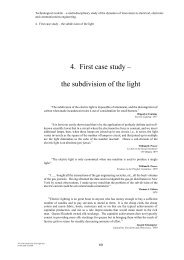Valuation Techniques for Social Cost-Benefit Analysis: - HM Treasury
Valuation Techniques for Social Cost-Benefit Analysis: - HM Treasury
Valuation Techniques for Social Cost-Benefit Analysis: - HM Treasury
Create successful ePaper yourself
Turn your PDF publications into a flip-book with our unique Google optimized e-Paper software.
18<br />
discussion here is also relevant to the non-monetary valuation of health states using qualityadjusted<br />
life years (QALYS). The standard gamble (SG) and time trade-off (TTO) mechanisms of<br />
assigning utilities to different health states essentially ask people to state their subjective values<br />
and thus share many of the problems related to stated preference techniques discussed below.<br />
Our attention in this paper is on monetary valuation techniques and thus we do not cover issues<br />
related to QALYS in further detail. Interested readers are directed to Dolan and Kahneman<br />
(2008) <strong>for</strong> a full discussion.<br />
Decision-making is a core element of preference-based methods; whether in a survey or realworld<br />
market setting economists observe people‘s decisions in order to infer values. Simon‘s<br />
(1955) theory of bounded rationality also sharply criticised the economist‘s view of individual<br />
decision-making by highlighting the role of perception, cognition and learning in the decisionmaking<br />
process. The resulting concept of preferences is that they are constructed at the time of<br />
elicitation and are context-dependent (Slovic, 2000). Ariely et al. (2006) even go as far as to say<br />
that people have no notion as to whether a good or product is even good or bad <strong>for</strong> them.<br />
Work in the fields of cognitive psychology and decision science highlights the notion that in the<br />
decision-making process people use a number of cognitive shortcuts, especially when the issues<br />
with which they are faced are unfamiliar and complex 3 . These shortcuts or ‗rules of thumb‘,<br />
which are used by individuals to simplify and speed up the decision making process, are called<br />
heuristics. Heuristics can lead to the generation of irrational preference relations and choices.<br />
This has obvious implications <strong>for</strong> both stated and revealed preference techniques.<br />
Heuristics<br />
Here we consider two categories of empirical finding that are thought to emerge from the use<br />
of heuristics:<br />
i. ‗utility misprediction‘; and<br />
ii. ‗anchoring‘:<br />
i) Utility mis-prediction<br />
Preference-based valuation methods require people to be able to predict the future utility<br />
consequences of consuming or <strong>for</strong>egoing a good. Numerous experiments have shown that<br />
people are unable to do this with accuracy (Kahneman, 2000). Kahneman and Snell (1992), <strong>for</strong><br />
example, report that people find it very hard to predict how much pleasure they will derive from<br />
consuming even everyday goods such as music, yogurt and ice cream. Participants were asked to<br />
consume these goods each day <strong>for</strong> a week. They rated their liking of the goods after each<br />
consumption and also predicted their liking and enjoyment of the goods <strong>for</strong> the following day.<br />
Correlations between predicted and actual enjoyment were negligible even in relatively large<br />
sample sizes. Nisbett and Kanouse (1969) and Read and van Leeuwen (1998) find evidence that<br />
shoppers who have recently eaten cannot <strong>for</strong>ecast their future food consumption and appetites<br />
accurately. Gilbert (2007) and Kahneman and Snell (1992) attribute these findings to a<br />
presentism heuristic; people project current tastes and desires on to their predicted future<br />
preferences.<br />
Other reasons <strong>for</strong> mis-predicting utility are adaptation and focussing illusions. Evidence from a<br />
number of different contexts suggests that individuals systematically fail to fully consider the<br />
extent to which they adapt to changes in circumstances. They there<strong>for</strong>e tend to over-estimate<br />
the utility gain that will result from events, circumstances or outcomes (Kahneman and Thaler,<br />
2006; Loewenstein and Adler, 1995). Frey and Stutzer (2004), <strong>for</strong> example,argue that people<br />
underestimate how quickly they will adapt to extrinsic goods, such as money. They there<strong>for</strong>e end<br />
3 Dellavigna (2009) provides a comprehensive survey of the empirical evidence relating to deviations from the standard economic model, divided into<br />
three categories – i) non-standard preferences, ii) non-standard beliefs, and iii) non-standard decision making





![AIRTO [Professor Dr Brian Blunden] - HM Treasury](https://img.yumpu.com/15492848/1/184x260/airto-professor-dr-brian-blunden-hm-treasury.jpg?quality=85)










